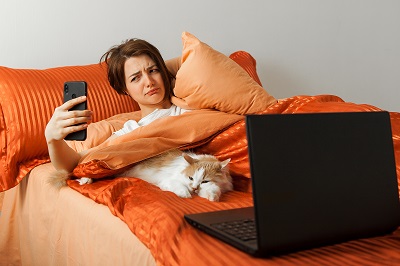 As the pandemic continues, most of us are working from home and experiencing “zoom fatigue” from the various video conferencing platforms.
As the pandemic continues, most of us are working from home and experiencing “zoom fatigue” from the various video conferencing platforms.
Zoom fatigue is real and researchers from Stanford have started to examine why we are being impacted by this new normal. Along with the inside scoop on this technological phenomenon, I’m including suggestions you can make right now to reduce the impact of “zoom fatigue”.
Why is Video Conferencing so Exhausting?
- Intense close up eye-contact. It sounds counter-intuitive, but making true eye contact is challenging on video platforms. During an in-person meeting people look around the room, take notes, doodle, etc., but when video-conferencing, people don’t do these things and tend to look at the participants more. The listener has almost the same attention focused on them as the speaker on a video conferencing call.
- Uncomfortable face size. If you have a large monitor as many of us do, the size of an individual’s face can be larger than is comfortable. This intensity can lead to a hyper-aroused state, as if there is danger. Close proximity is better suited to someone you know well (such as a friend or family member).
Solution:
Reduce the size of the zoom window relative to the monitor. This will subsequently reduce the size of the individuals on your screen. Also moving the keyboard farther away from the camera will create distance and space reducing the intensity. Turn the video off.
- Seeing yourself constantly causes fatigue. It is like looking in a mirror all day long. Stanford researchers found that women are triggered more by the self-view than men resulting in more negative thoughts about their appearance and how they look on the screen. Women also feel they must stay centered in the camera view more than men.
Solution:
Right click on your image in the video conferencing platform and select “hide self-view”. If your platform doesn’t include this feature, do it the old-fashioned way, and cover your image with a post-it note. Simple, but oh so effective.
- Decreased mobility. People are not moving around as much when spending significant amounts of time video conferencing. Researchers note that individuals perform better mentally when they are moving around.
Solution:
Ask yourself, “is video necessary for this meeting?” If it’s not – turn it off! When the video is off, people will move around more naturally, if only to stretch or walk around their space. Turning away from the screen will also help.
- The cognitive load is too high in a video conference meeting. This is what results in fatigue. When on video we work harder to send and receive messages, which is not natural, and does not come easily or without a cost. For example, making sure you nod in response to someone is typical when on a video conference call. We tend to focus on these extra levels of communication – and it can be exhausting.
Solution:
Turn the video off and take a break.
Additional and Fascinating Insights
- Extroverts experience less tiredness than introverts
- Calm people feel less fatigue than those with anxiety
- Younger people experience more tiredness than older people
- People of colour feel more fatigue than white people
Many organizations have reached out to Stanford communication researchers to help create best practices and guidelines for their video conferencing setup. In response, the Zoom Exhaustion & Fatigue Scale (ZEF Scale) was devised and is now being tested. The ZEF Scale breaks down zoom fatigue into 5 sub-types: emotional, motivational, visual, social, general. Learn more or participate in the research study by following this link.
Stay safe. Get vaccinated. Listening. Guiding. Caring.






